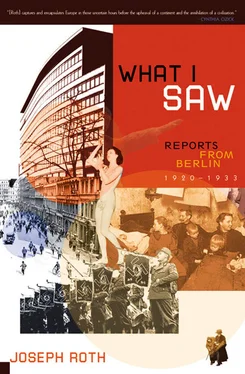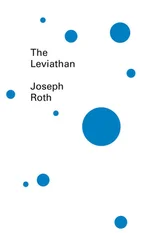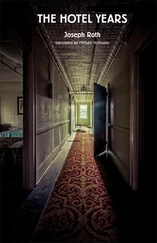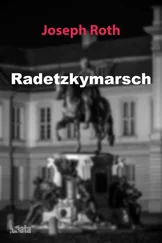The little house of the guard, the human being, looks like a little toy box. It is all so tiny and inconsequential, whatever he does in it, whatever happens to him. Irrelevant that he has children and that they fall ill, that he digs potatoes and feeds his dog, that his wife scrubs the floors and hangs out the wash. Even the great tragedies within his soul are lost here, as if they were no more than minutiae of his existence. His “eternal human” attributes are — if anything — merely an irritating side effect to his professional functional ones.
Can little heartbeats still make themselves heard where a big booming one deafens a world? Look at the triangular railroad junction on a still night, its vale silvered by the light of ten thousand lamps — it is as exalted as the spangled night with stars: caught in it, as within the glass bell of the atmosphere, are yearning and satisfaction. It is beginning and stopping-off point, the introduction to a beautiful and audible future music. The rails slip and glimmer away — transcontinental hyphens. Their molecules carry the hammering sound waves of distant clattering wheels, switchmen spring up by the trackside, and signals blossom in their lovely luminous green. By the grace of a mathematical system that itself remains concealed, steam escapes, hissing, from opened vents, levers move of their own accord, the miraculous becomes real.
So vast are the dimensions of the new life. That the new art which is to shape it cannot find a form for it is perfectly understandable. The reality is too overwhelming to be adequately represented. A faithful “depiction” is not enough. One would have to feel the heightened and ideal reality of this world, the Platonic ideal of the triangular railroad junction. One would have to affirm its harshness with enthusiasm, see the operation of “Ananke”* in its deadly effects, and prefer destruction by its laws to happiness by the “humane” laws of the sentimental world.
The world to come will be like this triangular railroad junction, raised to some unknown power. The earth has lived through several evolutionary stages — but following always natural laws. It is presently experiencing a new one, which follows constructive, conscious, and no less elemental laws. Regret for the passing of the old forms is like the grief of some antediluvian creature for the disappearance of a prehistoric habitat.
Gray, dusty grasses will sprout shyly between the metal tracks. The “landscape” will acquire a mask of iron.
Frankfurter Zeitung, July 16, 1924
Part V. Berlin Under Construction
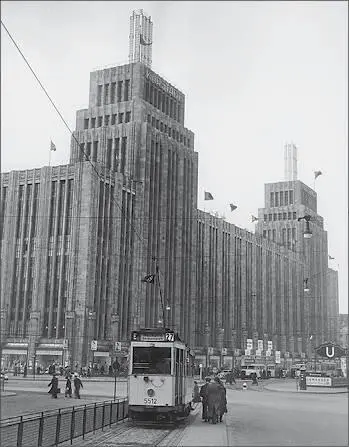
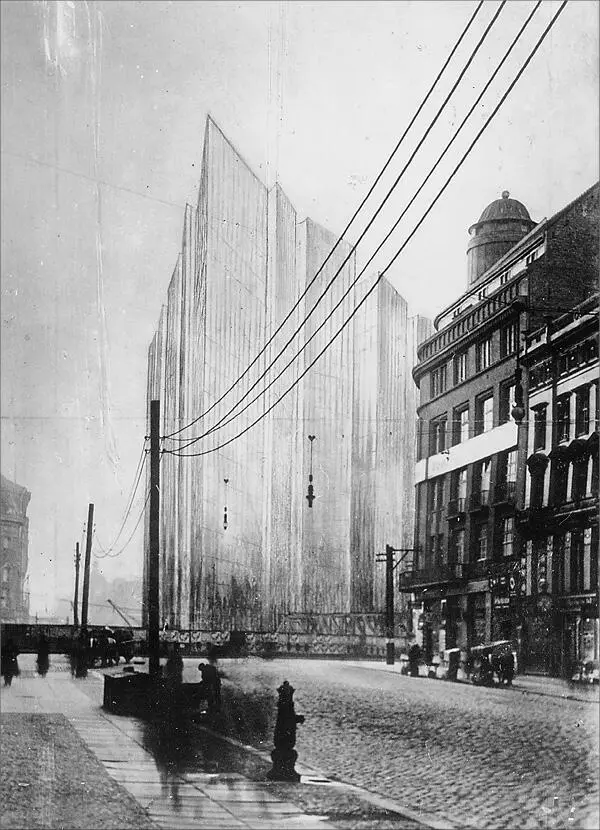
For some weeks there has been a fascinating exhibition at the City Hall of designs for large buildings. We hear now that the construction of a skyscraper is to be brought forward. It will be Germany’s first.
“Skyscraper” is no technical term, but the popular word for those huge buildings you see in photographs of Manhattan streets. It’s a picturesque and rather romantic name. It’s the name for a building so tall that its roof, as it were, scratches the sky. There is in the word something of the assertive, revolutionary quality of the builders of Babel.
A skyscraper is the incarnate rebellion against the supposedly unattainable; against the mystery of altitude, against the otherworldliness of the cerulean.
The skyscraper stands at the summit of technical development. It has already overthrown the cold sobriety of “construction,” and has begun to approach the romance of nature. The cloud, that remote, wonderful puzzle of creation, God’s blessing and curse, two-handed mystery bringing life and destruction, prayed to and dreaded by our ancestors, is now to be made habitable, even cozy. We will make ourselves comfortable among the clouds. We will tell them of the absurdities and the serious things of this world. They will hear the clatter of typewriters and the ringing of telephones, the knocking of central heating, and the dripping of faucets.
It will be a sort of return of the evolved human to the primordial forces of nature. This is an important juncture, and it seems to me we have not paid sufficient attention to it. The building of the first skyscraper is a historical turning point.
WHENEVER I LOOK at pictures of New York, I am filled with awe at the omnipotence of human technology. In this next stage of its development, civilization will have the opportunity to draw nearer to the old notions of culture.
When the steam locomotive was first invented, the poets moaned about the defilement of nature; the imagination predicted terrifying dystopias: whole tracts of the world devoid of grass and trees, rivers dried up, plants withered, butterflies poisoned. They didn’t understand that every new development constitutes a mysterious circle, in which the beginning and end touch and become identical.
Because the invention of the airplane was not a declaration of war on winged creatures, quite the opposite: It was fraternization between man and eagle. The earliest miner did not barge his way sacrilegiously into the depths, he returned home to the womb of Mother Nature. What may have the appearance of a war against the elements is in fact union with the elements: man and nature becoming one. There is exhilaration in skyscrapers as much as on mountaintops.
The long-desired fulfillment of some of the profoundest wishes of Earth: to overcome shortage of space by elevation and conquest of vertical space. Exploitation of every dimension: exaltation, visible from outside, that also communicates itself to the spirit within.
It is impossible for the proximity of clouds to have no effect on human beings. The view out of the window, taking in the full boundlessness of the horizon, works on both heart and soul. The lungs take in the air of heaven. Clouds wander past the brows of mortal man as previously only around the brows of Olympians.
I can see the skyscraper: a slender, floating construction on its broad pediment, noble and delicate in its lines, whose white and gray sets itself apart from the blue sky. Strong and safe in its assembly, it matches a natural mountain for strength.
Ten thousand people daily flow in and out of it: little office girls, emerging from the tight courtyards of the north of the city, quick tick of heels, black leather handbags swinging, filling elevators, shooting upward like a swarm of swallows.
Men striding out, purpose in their eyes, enterprise in their loose limbs; machine rattle and clatter of conveyances; shouted order of command; the even beat of mechanical perplexity, working toward a common end.
And up above God is disturbed in his everlasting tranquillity, and compelled to take an interest in our tiny destinies.
OH — AND ALREADY you hear that the first skyscraper in Berlin is to contain a great entertainment palace, with cinemas, dance hall, bar, Negro bands, vaudeville, jazz.
Because human nature will not deny its weaknesses, even where it is seemingly in the process of overcoming them.
And if it were possible for us to build a “planet scraper” and to construct settlements on Mars, the expeditions of scientists and engineers would be accompanied by a delegation of bartenders.
I have a shining vision of a bar in the clouds. It’s raining champagne cocktails.
Berliner Börsen-Courier, March 12, 1922
It happens from time to time that I fail to distinguish a cabaret from a crematorium, and pass certain scenes actually intended to be amusing, with the quiet shudder that the attributes of death still elicit. Such confusions would not have been possible in previous years. Ugliness, coarseness, and failure could always be brought into some relation to beauty, elegance, and good quality. A building that bore a fleeting, if distressing, resemblance to a classical temple was certain to be a theater for light opera. Something resembling a church was a main railway station. It was embarrassing, but somehow handy. You knew exactly how the deception operated, and never failed to recognize the fake when you saw the true. If you thought you saw marble, you knew you were in the presence of plasterboard. But ever since people have had the idea that modern times needed “modern styles,” all the old rules of thumb have stopped helping me. It’s as if all the gobbledygook I’ve learned with so much effort has suddenly been invalidated. It happens from time to time that in my hurry to catch a train I look for a cinema, thinking thereby to find the station. But my method no longer works. The building I took for the station turns out to be a “five o’clock tea” house in a sports palace. The facades of these modern times are unsettling me.
Читать дальше
